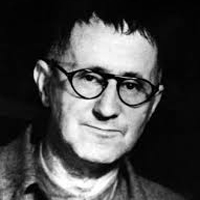Elements of Experimental Modernism in Brecht's Galileo
Bertolt Brecht belonged to the school of epic theatre. This theatre is non-conventional and against the Aristotelian theory of theatre. Brecht has used many elements of experimental modernism in his play Galileo. Brecht has used epigraph at the head of each scene. Each epigraph at the head of each scene gives brief clues about what is going to happen in each scene. This implied meaning in each epigraph prevents the readers from harboring suspense and anticipation about the forthcoming and upcoming events.

Bertolt Brecht (1898-1956)
Watching the play Galileo we begin to harbor anticipation and suspense, Brecht subverts their suspense and anticipation. By doing so he renders an entire dramatic action loose and thinly connected. Traditional drama allows readers to develop anticipation regarding to what kind of forthcoming outcome occurs. Right from the beginning of the play, readers are inclined to develop curiosity about how the play ends, and what would be the nature of the climax, but in Galileo Brecht simultaneously subverted the simultaneous emergence of the national curiosity of the readers. Hence, the play Galileo is designed to break simultaneously the emergence of the natural curiosity of the readers. In this regard the play Galileo sounds somewhat experimental.
Unlike other traditional plays Galileo is not divided into acts, it is a collection of a dozen of scenes. These scenes are loosely connected. There is a thin thread of unity which merely binds all these scenes. Like an epic, Galileo presents the life of the seventeenth century scientist Galileo. The play is not limited in presenting the life of the protagonist in a fixed period of time and space. Rather, it presents the total lives of Galileo from the day of his engagement in the scientific quest to the day of his difficult life in confinement. In terms of its incorporating power the play assumes an epic dimension. That is why it belongs to the school of epic-theatre. Aristotle's theory of three unities is mockingly defied in Galileo. Similarly Brecht inverted the Aristotelian principle of plot construction in the line of causality. The action in Galileo can hardly be divided into exposition, rising action, climax, denouement, falling action and resolution. The readers are previously well-acquainted with the story before watching the play. While watching the performance of Galileo, the spectator already knows that Galileo recants before Galileo actually recants in the play. Thus, this play does not succeed in evoking thrilling wonder and joy. It does not evoke thrilling wonder and joy because it is structurally designed to meet that goal. In this context the play appears to have carried an ingredient of modernism.
The play Galileo employs the seventeenth century scientist name Galileo as its protagonist. Hence the protagonist Galileo does not have the level of heroic stature and elite nobility. The protagonist is not seen struggling to maintain his heroic dignity like Antigone and Oedipus. Rather Galileo degenerates from the middle level of moral heroism by recanting what he had claimed scientifically. Hence, the protagonist Galileo is not larger than the life the way Oedipus and Othello were. The modernist element of the play Galileo resides in its inclusion of a protagonist who happens to keep an anti-heroic stature.
The spectators observing the enactment of Galileo could not identify with Galileo because of his recantation. When we find Galileo recanting because of the fear of punishment, we look down at him. At that moment of recognition Galileo appears to be a petty coward. We become alienated with him. Thus, the play produces an alienation effect upon its reader. The modernist element of the play is constituted by the situation of an alienation effect or in other words de- familiarization effect.
The very introduction, lighting, props, play cards, fitful costumes also collectively serve to reduce the realistic effort. This aspect of theatrical innovation helps to produce an element of modernism in Galileo.
The greatest modernist break through attained by Galileo is the invention of the chronological ordering of the events in the plot. In Galileo events are not arranged chronologically. There is no causal connection between the preceding and the succeeding events in the plot.
Song and dance are also used to hint at the undeclared theme. To popularize and spread Galileo’s recently found scientific truth, a couple dances in public. Their dance is subversive of the hierarchy in the Ptolemaic – Aristotelian universe. Just before the curtain falls the boys sing. Their song is a mockery of scientific truth. They mocked an old woman, they called her a witch. Andrea told them to believe in what they saw with their naked eyes. But they disbelieved. They continued to reveal their superstitious inclination by calling an old woman a witch. Their song, thus exemplified the harrowing success of an organized Christian dogma and the humiliating abortion of scientific enlightenment.
Surveying from top to bottom Galileo gives an every impression of becoming a modernist play, which brushes aside the illusionist convention. It stands as a landmark victory in the 20th century history of modernist plays.
Galileo Study Center
Introduction of Brecht's Galileo
Dramatic Irony in Brecht's Galileo
Significance of Telescope in Brecht's Galileo
Brecht's Dramatic Technique in Galileo
Conflict between Faith and Doubt in Galileo
Marxist Standpoint of Brecht in Galileo
Spirit of Science and Galileo in Brecht's Galileo
 |
bachelorandmaster.com |